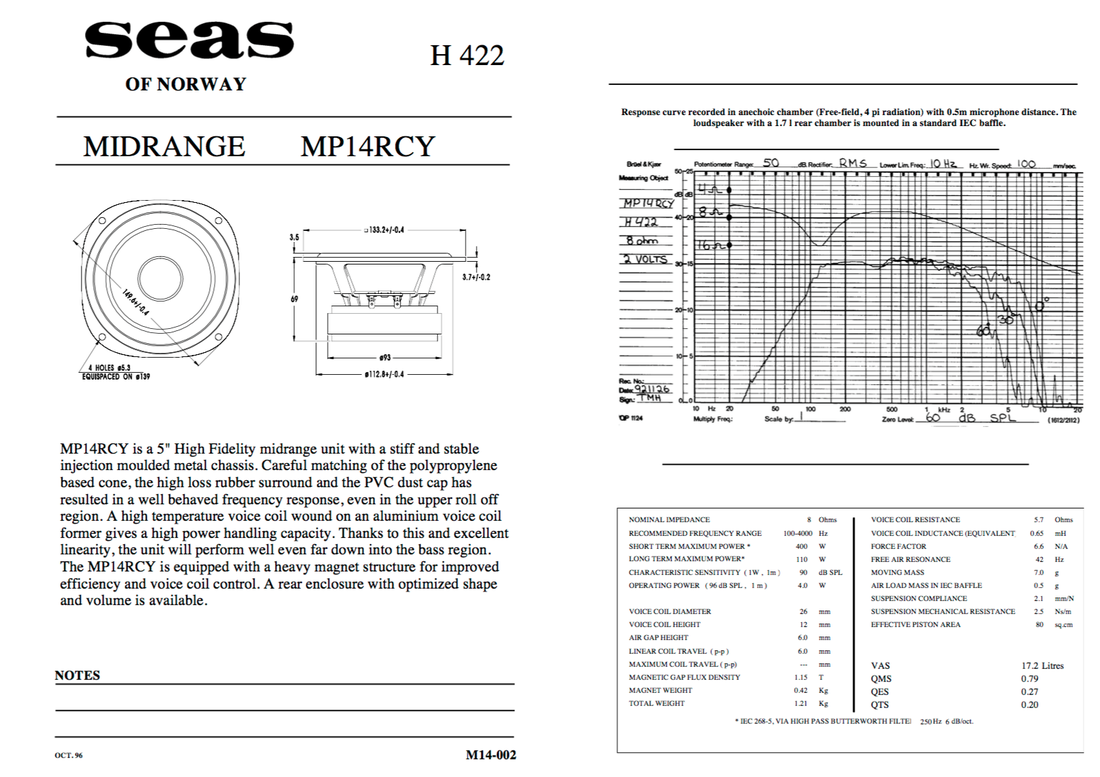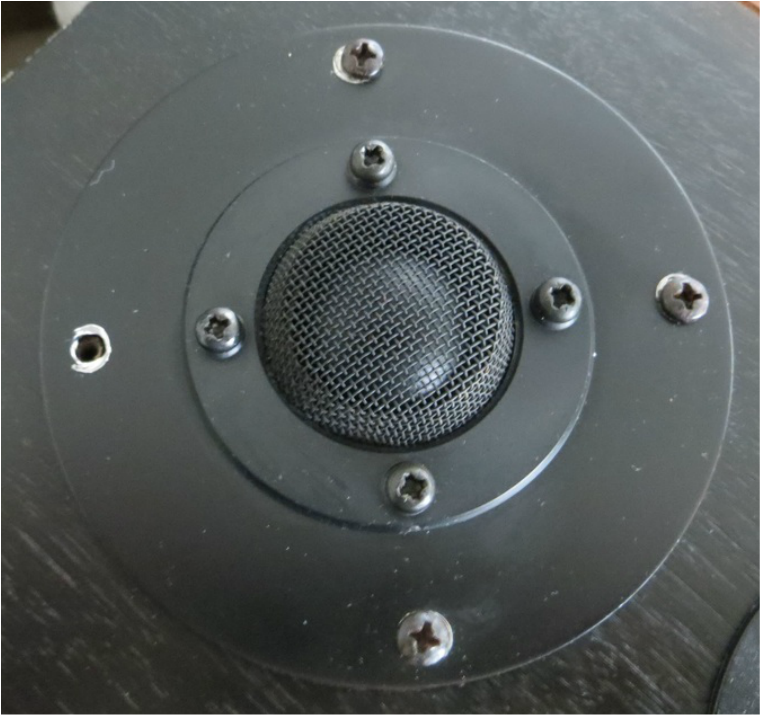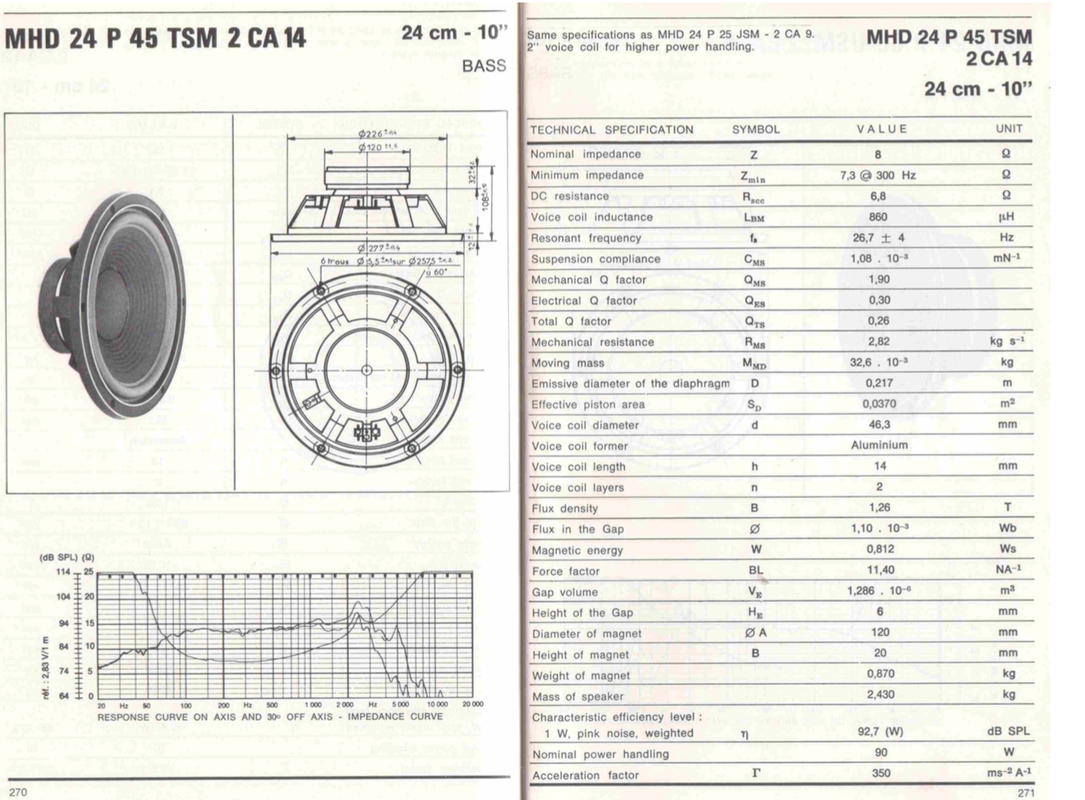|
A reader from the Netherlands who owns a pair of these speakers, and a talented architect, triggered several weeks of research and accumulation of documents, reading of forums entries to try to tell the story of this iconic brand of French speakers active for 15 years or so... I have to credit again cabinetmaker extraordinaire Jean-Paul Guy for sending me his complete file, including original drawings and hand-written notes from Jean-Claude Fourrière, the founder. Dear readers, this is all pre-CAD, email and Internet. We didn't have mobile phones, and most communications were via landlines and fax machines, or slow mail... Just that alone meant that it took time to get anything done, and mistakes were costly, very... So, with that sort of documentation, producing anything to the standard that GUY HF was producing at the time is a near miracle, and it is a tribute to Jean-Paul that the results were always far superior than these drawings suggest. Here is a copy of the 1985 catalogue But the story starts 10 years earlier when Jean-Claude Fourrière is approached by DECCA to design a monitor loudspeaker using the legendary ribbon tweeter developed by Stanley Kelly. And we don't know how that happened... In most loudspeaker systems the Deccas were used in a passive configuration Later he developed the ALH full range plasma loudspeakers.) Fourrière used the Decca London Ribbon from 2000 Hz. Decca Special Products in England authorized him to use the denomination DECCA and he named his creation Decca AL2000. It was a 3-way system with complementing units from Audax (HD24 and HIF13). He also designed a 2-way system at the time: DECCA AL1500 with crossover frequency of 1500 Hz. The panels of the cabinets were heavily damped with sheets of lead. Photos below courtesy of www.soundfountain.com From that same website, I made the extraordinary discovery that this ribbon tweeter could be compared in performance, and particular high frequency extension to the ubiquitous and far less expensive AUDAX TW8, which Elipson used on their "boules" and that I used in my very first design in 1971, as did Renaud de Vergnette in his first commercial Triangle speaker! What triggered this article as mentioned before, was an email from Jan H. who asked me to help him identify a pair of Audio Reference speakers he owns and to find out some specifications. He ended up sending me a number of great photos that he has given permission to share with you, you insatiable lot of hifi nerds and loyal readers of this blog! The difficulty in identifying these vintage speakers comes from the fact that these small manufacturers were changing their configuration often without changing the model number! This is a perfect example, as the REF 65 in the catalogue above shows both midrange drivers as domes (from SEAS), but this early version (my guess...) uses a MP14RCY from SEAS polypropylene cone. This, I believe, would have been a lot easier to crossover to the 24cm from Audax in the separate but integrated subwoofer. I have personally experimented at the time with a Dynaudio dome midrange and found it very difficult to use for that reason (and I have never been a great fan of Dynaudio drivers, or finished speakers for that matter...) D25This midrange crosses over to two Audax tweeters, the very reputable HD100D25 and TW74, a larger flange version of the famous TW51, described as a super tweeter...and also used by Confluence on their Cantilene, and by myself on the Microphase SAT and many other manufacturers. Audax at that time was producing 10,000 units a day! mainly for TV sets. The bass section is handled by a MHD24 from Audax in a separate enclosure, acting as a bass-reflex loaded subwoofer down to 35Hz. The entire speaker is deemed to go up to 26 kHz! Obviously, with four drivers to take care of, the crossover needs to be quite a complex affair. We would certainly try not to use electrolytic capacitors in a modern design, but technically when they are used in the low pass section, they are not in the signal path and therefore should not have an influence on the quality. However, 30 years later, I would replace these capacitors by a Mundorf or equivalent, just because they are probably not 12 uF anymore and their leakage would be significant and that would move the crossover frequency significantly. All other components are of quite good quality for the time and should still be fine. Although we do not have the value of all components, reverse engineering from the capacitors values and the frequency response of the drivers suggest crossover frequencies of 300 Hz for the woofer at 12dB/oct, 2000 Hz for the midrange and the HD100 at 12dB/oct, then around 4.5Khz for the TW74 at 6dB/oct. Various other resistors and capacitors may have been used to adjust levels and impedance compensation on the TH74, a good way to get reed of a nasty resonance. We might do some more research to clarify, or if somebody has the schematics, then we would be sorted... I do not have a review of that speaker, although I have a number of them for other speakers in the range, which I will publish in a second episode to be published in the coming weeks. In conclusion, Jean-Claude Fourrière was an inventor and a nuclear scientist, and he eventually went broke trying to design a commercially viable plasma headphone and full range speaker, the AHL Toltèque, which also had the benefit of being an open baffle design. Although he got some subsidies from ANVAR, the innovation French body, the product was too difficult to manufacture and the price made it very difficult to afford. Having said that, in his heydays, he had almost a hundred retailers throughout France and was doing quite well exporting to Europe and America.
Leon Suter and Lee Gray of Kyron Audio were kind enough to spend a few hours listening to my vintage contraptions, aka my Microphase speakers. My current subwoofer is slightly bigger than the original and now sports a 10" XXLS from Peerless with its own 200w amplifier, and the tweeter now upgraded to a 1" VIFA.
Electronics include a NAD preamp, Bryston 3B amplifier and OPPO player. The Bryston feeds the satellites directly and the preamp drives the Bryston AND the subwoofer's amp separately. I found that setup to give the most control on one end and the best sound out of the satellites, as they are not filtered at the bottom end. I hope they will leave their own comments below, and without wanting to reveal too much of their reactions, I was pretty chuffed when they said that these speakers "would have created quite a sensation" at the time! Quite not big enough obviously, but what not cease to amaze me is that after 30 years, they still sound as accurate and dynamic as they were then. Some might say than they have been truly broken in by then... We listened to Alchemy Live by Dire Straits , Modern Cool by Patricia Barber on Blu-Ray, Anouar Brahem, The Astounding Eyes of Rita on ECM and an historic recording of Bill Evans, Live in Paris, 1972 Vol 2 recorded by Radio France at the time and pressed by the Institut National de l'Audiovisuel (INA) in 1988. we also listened to a famous French percussionist Jean-Pierre Drouet, a digital file kindly "loaned" to me by Alain Wacquet of AW Audio fame. Lee is a percussionist himself, Leon a clarinetist, btw, so he could really appreciate the soundscape! We had a great time and I had to push them out of the door as they had a plane to catch back to Melbourne. Thank you guys, it was good to have you in my patch this time! This 12th edition of "Salon du Vintage" in Paris will have a section dedicated to Vinyl and an exhibition of the famous Elipson vintage speakers - with tons of speakers - literally - on loan from Jullien of Passion Elipson's fame
I am sure the new/old BS50 will be on display. So for your dose of nostalgia, rush to the "Enceintes en Blanc" event in Le Marais this week-end. Check their website for details: http://salonduvintage.com  One of my friend and ex-HP colleague is selling his system after 25+ years of good service, because it is supposedly too big for his new "maison de campagne"... And I thought we had designed it to be the most "WAF" friendly system on the Planet! "Des gouts et des couleurs, on ne discute point"... So, if any of you dear readers are interested in a pristine Triton passive system at a bargain price, here is your chance! If I were not so far away, I would buy it myself, as I do not have this system in my collection. Being in Australia would probably cost me more in shipping than the gear itself, although I am tempted! Anyway, to do justice to the product and help out my friend Philippe, I have posted a review of this wonderful triphonic system as an add-on to a previous post featuring the active version of this magnificent piece of french vintage hifi! You will find the review written by Patrick Vercher in the now defunct "Revue du Son" here: http://www.frenchvintagehifi.com/1/post/2011/07/microphase-triton-active.html Any enquiries are welcome via our "contact" form  Roquemaure is a picturesque village on the west bank of the Rhone river, drinking distance from Chateauneuf-du-Pape, Lirac, Tavel and many more famous wineries - including my favourite Cotes-du-Rhone: Vidal-Fleury! Christophe Bedel, the enthusiastic and knowledgeable owner of related website www.hifi-vintage-audiophile.fr has just been in contact with me asking if I could promote this event on my blog. I couldn't refuse! In fact, I am trying to convince Greg Borrowman from AHM, who will be in France at that time visiting Focal and hopefully Waterfall Audio to stop by and report on the only fair of this type I know of in the South of France! This is good timing too as a number of Festivals are happening in the region over the summer period, with usually a fantastic array of live concerts to choose from - Avignon being the most famous of them, but Uzes, Carpentras, Bagnols sur Ceze, La Roque d'Antheron ( a must!), Aix en Provence, Orange and Nimes all competing for your time (and good money..) So, if you are one of 43 out of 100 Australians out of the country at any given time, or one of my readers in any of the 70 countries or so where I have an audience, and if you happen to be in Provence for the European Summer, just drop by and have a look at the fantastic collection of vintage Hifi that will be on display and for sale! I will update this post with an exact address as soon as I get it, but if your French is good enough, then visit Christphe's website: www.hifi-vintage-audiophile.fr  When in Paris in October for the Paris Hifi Show, I took the time to go and visit two shops specialising in Vintage Hifi, with a great collection of French products from the 70s and 80s, but also some iconic products from Germany, Switzerland, UK, USA and Japan. Read my review on our "Interviews and Reviews" page and then visit their websites for more photos and technical specs, and who knows, maybe buying the rare amp or speaker or turntable you have been dreaming of for some time... |
AuthorBorn in France, well travelled, relocated to Sydney in 1997. Archives
July 2023
Categories
All
|


































 RSS Feed
RSS Feed
